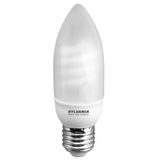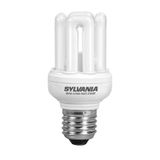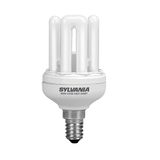Sylvania Compact fluorescent lamps with integrated ballast




Ceiling and wall fixtures in legacy estates still carry millions of E27/E14 sockets. Where LED migration is staged or photometrics are already signed off, self-ballasted CFL (CFLi) remains a practical stop-gap: predictable geometry, calm mains behaviour on 220–240 V, and familiar optics behind opal shades and louvers. Typical metrics: 5–23 W classes, ~250–1,600 lm, CRI ≈80, CCT 2700–6500 K, warm-up to 80% within 30–60 s, switching endurance dependent on preheat chemistry and duty cycle.
sylvania compact fluorescent lamps with ballast performance and scope
These self-contained lamps integrate the starter and control gear, so installers only check cap type, wattage class, and envelope size. In open fittings they run cool; in enclosed domes verify clearance and airflow. Many sylvania compact fluorescent lamps with ballast specify PF around 0.55–0.60 on small sizes and ≥0.9 on high-power SKUs, with THD within typical building limits.
sylvania cfl lamps with integrated ballast formats and caps
A-shape, mini-spiral, U-bend, and globe envelopes cover general light and shaded fixtures. Caps include E27/E14 screw and B22 where estates require bayonet. For clean handovers, crews standardise base type by floor so sylvania cfl lamps with integrated ballast swap one-for-one without chasing adapters or trim rings.
sylvania energy saving lamps metrics and compliance
Efficacy sits ~55–75 lm/W depending on CCT and envelope; lifetime 6,000–12,000 h to maintenance thresholds when switching is moderate. Thermal windows typically −10…+45 °C; avoid frequent short cycles that spike cathode wear. Safety/performance follow long-standing CFLi norms (e.g., EN 60968/60969 references in legacy specs), which procurement teams still cite when qualifying sylvania energy saving lamps for interim use.
sylvania compact fluorescent bulbs applications and compatibility
Office troffers with opal diffusers, hospitality shades, and residential corridors are straightforward; stair cores on rapid presence control are not—set minimum on-time ≥3–5 min to protect cathodes. Enclosed bathroom domes need temperature checks. Where dimmers exist, only marked dimmable sylvania compact fluorescent bulbs should be released; phase type and minimum load must match the lamp list.
sylvania cfl retrofit lighting commissioning notes
Label converted fittings clearly, record lamp wattage/CCT per room, and align replacement cycles with cleaning rounds. Emergency circuits stay upstream of any local switching so test routines aren’t masked. In mixed floors, grouping sylvania cfl retrofit lighting by cap/base and lumen class keeps van stock lean and avoids brightness patchwork.
sylvania plug-in cfl lamps integration and migration
Not to be confused with CFLi: sylvania plug-in cfl lamps are external-gear types (G24/GX24/2G11 etc.). On phased programmes, teams often run CFLi in screw-cap areas while planning gear changes on plug-in luminaires; documenting both paths in the schedule prevents mismatched spares.
sylvania fluorescent energy saving bulbs selection and procurement
Start with the photometric target, then lock wattage and CCT/CRI; check envelope diameter/length against shades and louvers; confirm ambient and duty cycle. Projects that tag sylvania fluorescent energy saving bulbs by EAN/MPN, lumen class, and envelope code keep replacements consistent across phases.
Technical specifications and standards for engineers
- Electrical: 220–240 V AC, 50/60 Hz; PF as declared per wattage class; THD controlled for building circuits.
- Photometric: CRI ~80 (CRI 90 niche SKUs), CCT 2700/3000/4000/6500 K; binning managed for batch consistency.
- Thermal/mechanical: −10…+45 °C typical; observe clearances in enclosed domes; glass or coated spiral envelopes sized to common shades.
- Controls: non-dimmable by default; use only dimmable variants with verified phase type and minimum load; presence timers set to avoid rapid cycling.
- Environment/EoL: mercury content within historic RoHS allowances; plan WEEE collection with site waste streams.
Applications and compatibility
- Education/office: moderate switching, 300–500 lx targets, neutral whites; avoid rapid on/off occupancy patterns.
- Hospitality: warm whites in shades, low glare; check globe diameter vs harp/finial clearances.
- Housing: corridor lighting with longer hold times; enclosed bulkheads require temperature headroom.
- Plant/service rooms: prefer cool whites; keep minimum on-times to stabilise start chemistry.
Integration with other Sylvania products
Pair CFLi areas with Sylvania wall keys and presence sensors configured for extended hold; align CCT/CRI with adjacent Sylvania luminaires so spaces read uniformly. Where migration to LED is planned, keep cap/base mapping and lumen classes identical to shorten approval loops later.
Selection criteria for B2B clients
- Photometrics: lumen class vs room size; CCT/CRI by zone; diffuser compatibility.
- Electrical: dimmer type and minimum load (if used); PF/THD by wattage; breaker diversity.
- Mechanical: envelope length/diameter; shade and louvre clearance; cap type by region.
- Operations: switching profile; spare policy by EAN/MPN; labelled fittings for fast audits.
Advantages of working with Bankoflamps
We align pricing to room schedules and show live EU stock before crews are booked. Quotes land in about an hour with EAN/MPN so variants stay fixed. Your portal lists lead times, shipment status, and downloadable price lists with stable validity windows. Approved accounts can use post-payment up to 30 days. We consolidate partials to cut freight, and an account manager cross-checks cap/base, envelope geometry, lumen class, CCT/CRI, dimming status, and ambient limits against your drawings so cartons arrive site-ready across France, the Baltics, Germany, Spain, Italy, Belgium, and the Netherlands.